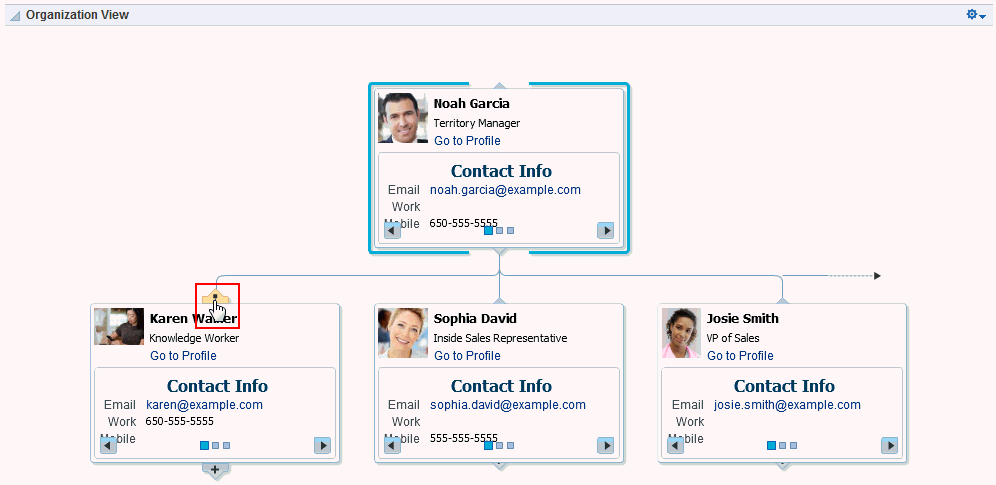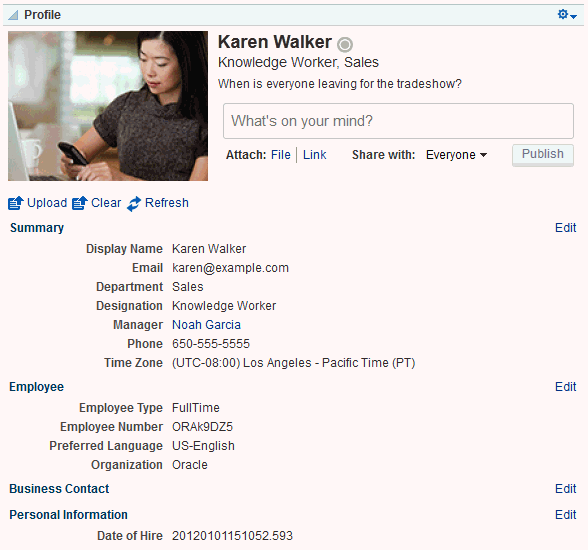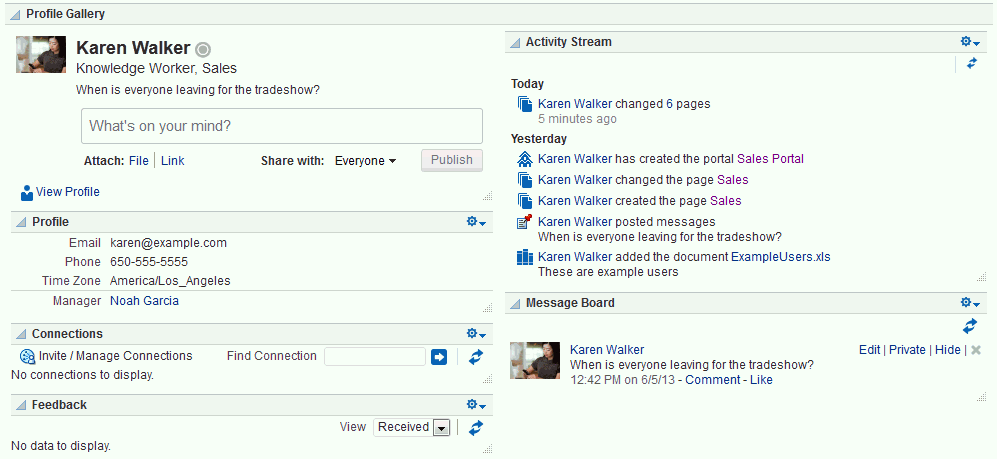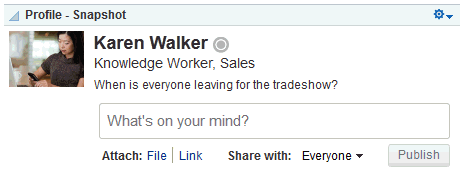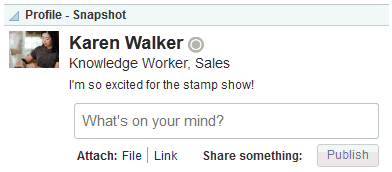53 Adding Profiles to a Portal
This chapter describes how to add Profile task flows to a portal. Profiles are a collection of useful data about each user, including contact information, a photo, location within the company hierarchy, and so on. The social networking capabilities in WebCenter Portal enable users to view and manage their own Profiles and to view the Profiles of others.
This chapter includes the following topics:
Permissions:
To perform the tasks in this chapter, you must be a portal moderator or a portal member with the portal-level permissions Basic Services: Edit Page Access and Structure (standard permissions) or Pages: Edit Pages (advanced permissions).
For more information about permissions, see Section 29.1, "About Roles and Permissions for a Portal."
53.1 About Profiles
Profile provides a variety of views into users' personal profile information. Such information can include mail address, phone number, office location, department, manager, direct reports, and so on. In a typical WebCenter Portal installation, Profile takes the bulk of its information from the back-end identity store that provides WebCenter Portal with its users (for more information, see the "Synchronizing Profiles with the Identity Store" section in Oracle Fusion Middleware Administering Oracle WebCenter Portal). Additionally, Profile may offer opportunities for altering some of this information and for providing additional data not included in the identity store.
Before users access their Profiles or Profile preferences, your administrator can set global application defaults that affect what all users may see and do with their own and other users' Profiles. For more information, see the "Configuring Profile" section in Oracle Fusion Middleware Administering Oracle WebCenter Portal.
Notes:
-
The Profile user interface was updated in . Depending on how your system administrator configured your installation of WebCenter Portal, you might see the legacy Profile user interface. For information on the legacy Profile user interface, see the "Managing Your Profile" chapter in the User's Guide for Oracle WebCenter Portal: Spaces for 11g Release 1 (11.1.1.7.0).
-
Empty fields (fields without any content) do not appear in some profile views.
Users access Profile information by clicking a user name wherever they see it in WebCenter Portal. Depending on where the user clicks in the portal, the either see a brief, popup view of the user profile or they see a full profile view on the WebCenter Portal Profile page. For information about how users interact with profiles and use Profile task flow features, see the "Managing Your Profile" chapter in Oracle Fusion Middleware Using Oracle WebCenter Portal.
In addition to the Profile page, Profile provides several task flows that each offer a unique view of a user's Profile information. Provided you have edit permission on a page, you can place a Profile task flow wherever you find it of use.
Profile provides the following task flows:
-
Organization View for a graphical depiction of the current user's position within the company—that is, a detail of the overall organization chart. In Organization View, you can cycle through three views of the current user's Profile information, including contact information; the user's address and the current time in the user's locale; and a summary About Me statement. It also provides a link to a full-blown profile of the current user (Figure 53-1).
See Also:
For information about enabling a hierarchical view of your organization, as depicted in Figure 53-1, see the "Specifying a Management Chain for Organization View" section in Oracle Fusion Middleware Administering Oracle WebCenter Portal.
-
Profile for displaying a user's profile details, uploading a photo, and (if enabled) editing Profile details (Figure 53-2)
-
Profile Gallery for accessing all of your social networking information from one view (Figure 53-3)
-
Profile - Snapshot for viewing a user photo and status message (Figure 53-4)
Profile task flows have associated properties that you can use to control the appearance and behavior of a task flow instance. For example, you can use Profile properties to specify that the statements you enter into a Publisher task flow (see Section 49.1, "About Message Board") are included in those Profile views that provide a status message. You can control whether a Profile allows the display of a photo and whether the photo can be updated in page view mode.
Note:
Empty fields (fields without any content) do not appear in some profile views.
See Also:
For more information about Profile properties, see Section 53.3, "Setting Profile Task Flow Properties."
53.2 Adding a Profile Task Flow to a Page
For the steps to add a Profile task flow to a page, see Section 12.4.7, "Adding Components to a Page."
53.3 Setting Profile Task Flow Properties
Profile task flows have associated properties, which users with sufficient privileges can access through the Component Properties dialog in Composer (Figure 53-5).
Figure 53-5 Profile Task Flow Component Properties Dialog
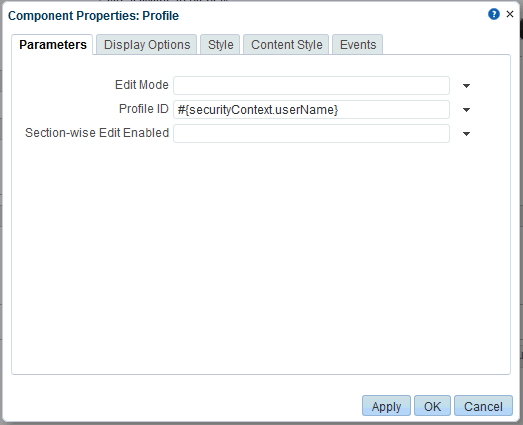
Description of "Figure 53-5 Profile Task Flow Component Properties Dialog"
See Also:
The following sections provide information about properties associated with Profile task flows and describe the properties available on the Parameters tab:
53.3.1 About Profile Task Flow Properties
When you set property values on a Profile task flow, you are affecting only the task flow instance on which the value is set. Other instances of the same task flow are not affected by such changes.
The properties on the Parameters tab of the Component Properties dialog can affect the default task flow content. For descriptions of the parameters on this tab, see Section 53.3.5, "Profile - Snapshot Task Flow Parameters." For some task flows, parameters on this tab facilitate the wiring of the task flow to page parameters and page definition variables. For more information, see Chapter 19, "Wiring Pages, Task Flows, Portlets, and ADF Components."
Changes to the properties on the Display Options, Style, and Content Style tabs affect the appearance and behavior of the task flow. These properties are common to all task flows. For more information, see Section 14.3.4, "Working with Component Display Options" and Section 14.3.6, "Working with Style and Content Style Properties."
The content of the Events tab depends on the events supported by the task flow. For more information, see Section 14.3.7, "Working with Component Contextual Events."
All properties on the Parameters and Display Options tabs provide access to an Expression Language (EL) editor, which you can use to select or specify a variable value instead of a constant value. Click the ![]() icon next to a property, then select Expression Builder to open the editor. If you need EL assistance, an application developer can provide an EL expression; see the "Expression Language Expressions" appendix in Oracle Fusion Middleware Developing Portals with Oracle WebCenter Portal and Oracle JDeveloper.
icon next to a property, then select Expression Builder to open the editor. If you need EL assistance, an application developer can provide an EL expression; see the "Expression Language Expressions" appendix in Oracle Fusion Middleware Developing Portals with Oracle WebCenter Portal and Oracle JDeveloper.
Note:
Wherever you enter EL on the generic Display Options tab in the Component Properties dialog, the entry is automatically validated. If the EL syntax is invalid, an error appears and the value is neither applied nor saved. Generic Display Options are those cataloged in Table 14-1, "Display Options Properties".
EL validation is not performed on non-generic display options.
53.3.2 Organization View Task Flow Parameters
Table 53-1 describes the parameters that are unique to the Organization View task flow.
Table 53-1 Organization View Task Flow Parameters
| Parameter | Description |
|---|---|
|
|
Determines whether the task flow displays a control panel for manipulating the style, alignment, and size of the content Select to show the control panel, deselect to hide the control panel. The control panel is hidden by default. |
|
|
The ID of the user to display in the task flow The value for this parameter, If you need EL assistance, an application developer can provide an EL expression; see the "Expression Language Expressions" appendix in Oracle Fusion Middleware Developing Portals with Oracle WebCenter Portal and Oracle JDeveloper. |
53.3.3 Profile Task Flow Parameters
Table 53-2 describes the parameters that are unique to the Profile task flow.
Table 53-2 Profile Task Flow Parameters
| Parameter | Description |
|---|---|
|
|
Determines whether to display Profile details as editable without requiring specific navigation to an editable view
When the value is set to This parameter is set to |
|
|
The ID of the user to display in the task flow The value for this parameter, If you need EL assistance, an application developer can provide an EL expression; see the "Expression Language Expressions" appendix in Oracle Fusion Middleware Developing Portals with Oracle WebCenter Portal and Oracle JDeveloper. |
|
|
Determines whether to display section-by-section edit capability in the task flow
This parameter is set to |
53.3.4 Profile Gallery Task Flow Parameters
Table 53-3 describes the parameters that are unique to the Profile Gallery task flow.
Table 53-3 Profile Gallery Task Flow Parameters
| Parameter | Description |
|---|---|
|
|
The ID of the user to display in the task flow The value for this parameter, If you need EL assistance, an application developer can provide an EL expression; see the "Expression Language Expressions" appendix in Oracle Fusion Middleware Developing Portals with Oracle WebCenter Portal and Oracle JDeveloper. |
53.3.5 Profile - Snapshot Task Flow Parameters
Table 53-4 describes the parameters that are unique to the Profile - Snapshot task flow.
Table 53-4 Profile - Snapshot Task Flow Parameters
| Parameter | Description |
|---|---|
|
|
Determines whether the task flow displays controls that enable users to upload, clear and refresh a profile photo Select to show profile photo controls, deselect to hide profile photo controls. The profile photo controls are hidden by default. |
|
|
Determines whether the task flow displays controls that enable users to enter a personal status message and attach a file or link to the message Select to allow users to enter a status message through the task flow, deselect to hide status update controls. The status message controls are shown by default. If status updates are enabled, users can enter updates through an embedded Publisher task flow. For information about the Publisher task flow, see the "Liking, Commenting On, and Sharing Items in WebCenter Portal" chapter in Oracle Fusion Middleware Using Oracle WebCenter Portal. |
|
|
Determines the size of the Profile photo displayed in the task flow Values can be one of: |
|
|
Determines whether a breadcrumb delineating the user's upward path in the organization hierarchy is shown Select to show the breadcrumb, deselect to hide the breadcrumb. The breadcrumb is hidden by default. |
|
|
Determines whether the task flow displays a link to edit the user Profile Select to show the Edit Profile link, deselect to hide the link. The link is hidden by default. This link does not perform any operation, but instead leads to a region navigation event (to the same view), which the consumer can listen to and perform navigation appropriately. Out of the box, the Profile business role page, which contains the Profile - Snapshot task flow, is wired to the Profile task flow on the About subpage. Upon receiving a region navigation event from the Profile - Snapshot task flow, clicking the Edit link switches the Edit Mode parameter of the Profile task flow on the About subpage, effectively toggling the mode. Because of this out-of-the-box wiring, the Edit link works on the My Profile business role page. If you plan to expose the Profile Edit link, you must retain the code to listen to the region navigation event and provide the same type of wiring to the target task flow. |
|
|
The ID of the user to display in the task flow The value for this parameter, If you need EL assistance, an application developer can provide an EL expression; see the "Expression Language Expressions" appendix in Oracle Fusion Middleware Developing Portals with Oracle WebCenter Portal and Oracle JDeveloper. |
53.3.6 Using Properties to Configure a Profile Task Flow Instance
This section provides examples of how you use property values to affect the behavior of a given task flow instance. It includes the following subsections:
-
Section 53.3.6.1, "Change Profile Photo in Profile - Snapshot Task Flow"
-
Section 53.3.6.3, "Expose Additional Controls in Organization View"
-
Section 53.3.6.4, "Enable Continuous Edits to Profile Details"
-
Section 53.3.6.5, "Setting Size of Profile Images in Profile - Snapshot Task Flow"
-
Section 53.3.6.6, "Exposing Navigational Breadcrumbs in Profile - Snapshot"
-
Section 53.3.6.7, "Enabling Section-By-Section Profile Editing"
53.3.6.1 Change Profile Photo in Profile - Snapshot Task Flow
Use the property Allow photo upload to enable users to upload their own Profile photos in an instance of the Profile - Snapshot task flow. When you enable photo upload, Upload, Clear, and Refresh controls appear below the photo display area (Figure 53-6).
Figure 53-6 Photo Controls on Profile - Snapshot Task Flow

Description of "Figure 53-6 Photo Controls on Profile - Snapshot Task Flow"
Note:
Photos uploaded to Profile - Snapshot are persisted to all other Profile task flows that expose a photo.
To enable users to change their Profile photo in the Profile - Snapshot task flow:
-
Open the Component Properties dialog for the Profile - Snapshot task flow instance you want to configure.
See Also:
-
In the Component Properties dialog, on the Parameters tab, select Allow photo upload.
Note:
To prevent users from changing their profile photos, deselect Allow photo upload.
-
When you finish revising component properties, click OK.
-
Save your changes, and exit the page editor.
53.3.6.2 Post a Status Update
Use the property Allow status update to show or hide a means of entering a personal status message in the Profile - Snapshot task flow. If status updates are enabled, users can enter their status messages through an embedded Publisher task flow (Figure 53-7).
Figure 53-7 Publisher Features in Profile - Snapshot Task Flow
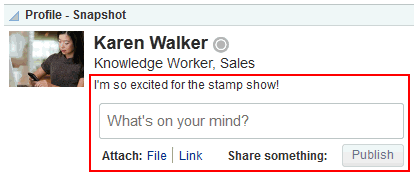
Description of "Figure 53-7 Publisher Features in Profile - Snapshot Task Flow"
See Also:
For information about the Publisher task flow, see Section 41.10, "About Publisher."
When this property is enabled, whenever the current user posts a status message using the Publisher task flow, it is also posted as a Profile status message to Profile - Snapshot, Profile Gallery, and Profile task flows.
To enable users to post a status update to their Profile:
-
Open the Component Properties dialog for the Profile - Snapshot task flow instance you want to configure.
See Also:
-
In the Component Properties dialog, on the Parameters tab, select Allow status update.
Note:
To prevent users from updating their profile status through this task flow, deselect Allow status update.
-
When you finish revising component properties, click OK.
-
Save your changes, and exit the page editor.
53.3.6.3 Expose Additional Controls in Organization View
The Organization View task flow provides additional controls for manipulating your view of task flow content (Figure 53-8).
Figure 53-8 Control Panel Shown in Organization View

Description of "Figure 53-8 Control Panel Shown in Organization View"
Use additional controls to zoom in and out and select a display format.
Use the property Control Panel Shown to expose these controls in an instance of the Organization View task flow.
To expose additional controls in an Organization View task flow:
-
Open the Component Properties dialog for the Organization View task flow instance you want to configure.
See Also:
-
In the Component Properties dialog, on the Parameters tab, select Control Panel Shown.
Note:
To hide the Organization View control panel, deselect Control Panel Shown.
-
When you finish revising component properties, click OK.
-
Save your changes, and exit the page editor.
53.3.6.4 Enable Continuous Edits to Profile Details
Use the property Edit Mode to enable users to edit Profile details without having to specifically enter an edit mode. Users navigate to the task flow instance and make changes to editable fields without having to first click an Edit button or link.
Note:
This parameter is recognized only if the parameter sectionWiseEditEnabled is set to #{false}. For more information, see Section 53.3.6.7, "Enabling Section-By-Section Profile Editing."
To enable continuous edits of Profile details:
-
Open the Component Properties dialog for the Profile task flow instance you want to configure.
See Also:
-
In the Component Properties dialog, on the Parameters tab, in the Edit Mode box, enter
#{true}.Note:
To require that users click an Edit button to take Profile details into edit mode, in the Edit Mode box, enter
#{false}. -
When you finish revising component properties, click OK.
-
Save your changes, and exit the page editor.
53.3.6.5 Setting Size of Profile Images in Profile - Snapshot Task Flow
Use the property Image Size to specify the display size of images that are uploaded through a Profile - Snapshot task flow. The value you enter affects the size of the photo in only the given task flow instance. No other types of Profile task flows and no other task flow instances are affected.
To set the size of a Profile image in the Profile - Snapshot task flow:
-
Open the Component Properties dialog for the Profile - Snapshot task flow instance you want to configure.
See Also:
-
In the Component Properties dialog, on the Parameters tab, enter a value in the Image Size box:
-
ORIGINAL(Figure 53-9) -
SMALL(Figure 53-10) -
MEDIUM(Figure 53-11) -
LARGE(Figure 53-12)
-
-
When you finish revising component properties, click OK.
-
Save your changes, and exit the page editor.
53.3.6.6 Exposing Navigational Breadcrumbs in Profile - Snapshot
Use the property Org Bread Crumbs Shown to enable the display of breadcrumbs that visualize the current users position in the organization hierarchy (Figure 53-13).
Figure 53-13 Breadcrumbs in Profile - Snapshot Task Flow

Description of "Figure 53-13 Breadcrumbs in Profile - Snapshot Task Flow"
Users can click a name in the hierarchy to navigate to a view of that user's Profile.
To expose navigational breadcrumbs in a Profile - Snapshot task flow:
-
Open the Component Properties dialog for the Profile - Snapshot task flow instance you want to configure.
See Also:
-
In the Component Properties dialog, on the Parameters tab, select Org Bread Crumbs Shown.
Note:
To hide hierarchical breadcrumbs, deselect Org Bread Crumbs Shown.
-
When you finish revising component properties, click OK.
-
Save your changes, and exit the page editor.
53.3.6.7 Enabling Section-By-Section Profile Editing
Use the Section-Wise Edit Enabled property to specify whether section-by-section editing is enabled, exposing Edit buttons on each editable section of a Profile task flow instance (Figure 53-14), or disabled, exposing only a single Edit button for the entire Profile (Figure 53-15).
Figure 53-14 Section-By-Section Profile Editing
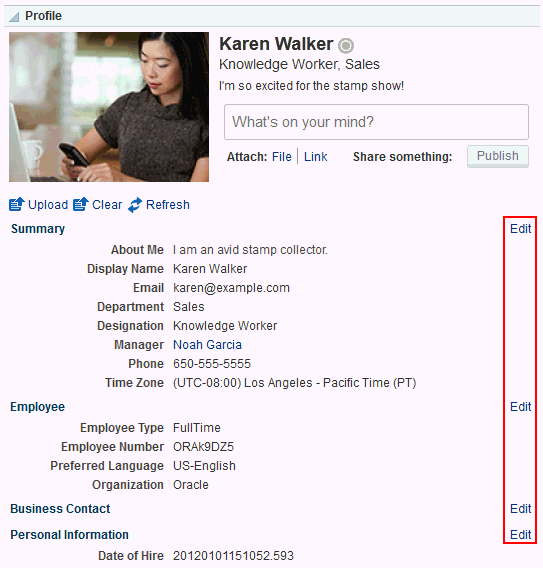
Description of "Figure 53-14 Section-By-Section Profile Editing"
Figure 53-15 Profile with Single Edit Button
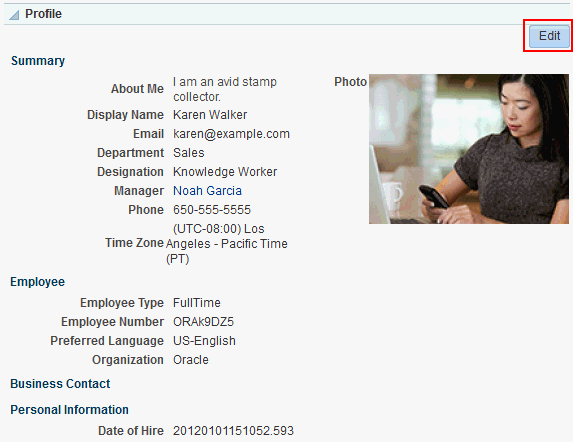
Description of "Figure 53-15 Profile with Single Edit Button"
Note:
Whether Profile details are editable in all Profile task flow instances is determined by your administrator. For more information, see the "Configuring Profile" section in Oracle Fusion Middleware Administering Oracle WebCenter Portal.
To enable section-by-section editing in a Profile task flow instance:
-
Open the Component Properties dialog for the Profile task flow instance you want to configure.
See Also:
-
In the Component Properties dialog, on the Parameters tab, in the Section-Wise Edit Enabled box, enter
#{true}.Note:
To show one Edit button for all the Profile details, in the Section-Wise Edit Enabled box, enter
#{false}. -
When you finish revising component properties, click OK.
-
Save your changes, and exit the page editor.
53.4 Working with Profile Task Flows
For information about how users work with Profile task flows, see the "Managing Your Profile" chapter in Oracle Fusion Middleware Using Oracle WebCenter Portal.
